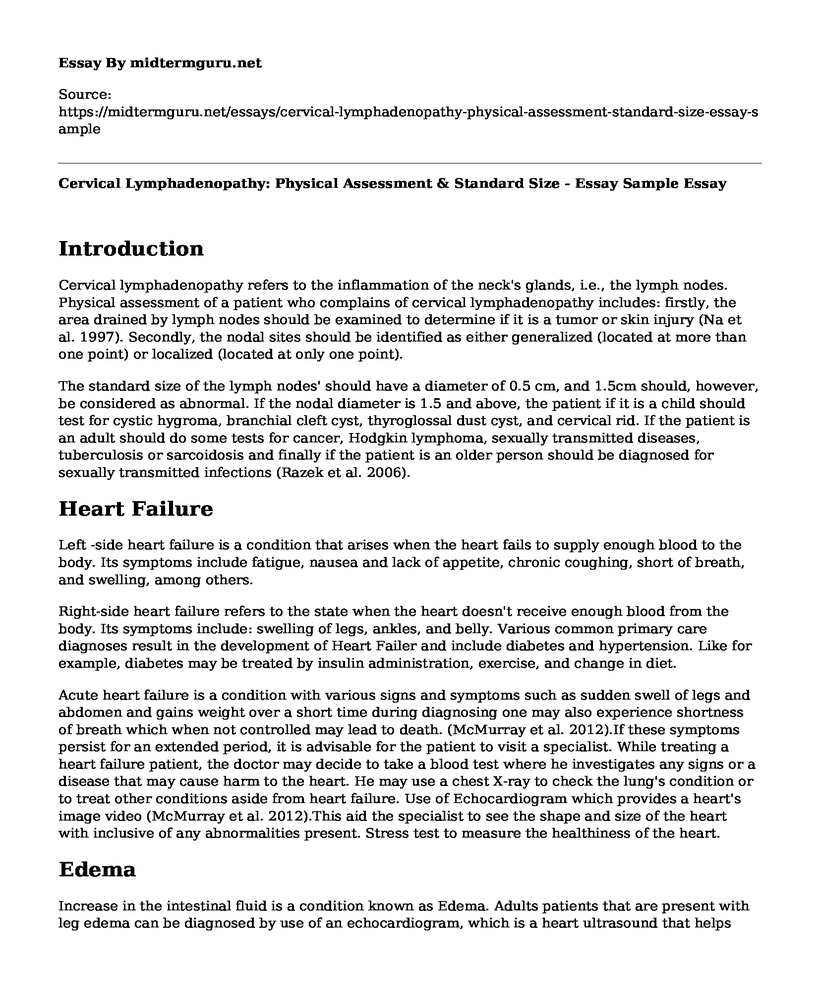Introduction
Cervical lymphadenopathy refers to the inflammation of the neck's glands, i.e., the lymph nodes. Physical assessment of a patient who complains of cervical lymphadenopathy includes: firstly, the area drained by lymph nodes should be examined to determine if it is a tumor or skin injury (Na et al. 1997). Secondly, the nodal sites should be identified as either generalized (located at more than one point) or localized (located at only one point).
The standard size of the lymph nodes' should have a diameter of 0.5 cm, and 1.5cm should, however, be considered as abnormal. If the nodal diameter is 1.5 and above, the patient if it is a child should test for cystic hygroma, branchial cleft cyst, thyroglossal dust cyst, and cervical rid. If the patient is an adult should do some tests for cancer, Hodgkin lymphoma, sexually transmitted diseases, tuberculosis or sarcoidosis and finally if the patient is an older person should be diagnosed for sexually transmitted infections (Razek et al. 2006).
Heart Failure
Left -side heart failure is a condition that arises when the heart fails to supply enough blood to the body. Its symptoms include fatigue, nausea and lack of appetite, chronic coughing, short of breath, and swelling, among others.
Right-side heart failure refers to the state when the heart doesn't receive enough blood from the body. Its symptoms include: swelling of legs, ankles, and belly. Various common primary care diagnoses result in the development of Heart Failer and include diabetes and hypertension. Like for example, diabetes may be treated by insulin administration, exercise, and change in diet.
Acute heart failure is a condition with various signs and symptoms such as sudden swell of legs and abdomen and gains weight over a short time during diagnosing one may also experience shortness of breath which when not controlled may lead to death. (McMurray et al. 2012).If these symptoms persist for an extended period, it is advisable for the patient to visit a specialist. While treating a heart failure patient, the doctor may decide to take a blood test where he investigates any signs or a disease that may cause harm to the heart. He may use a chest X-ray to check the lung's condition or to treat other conditions aside from heart failure. Use of Echocardiogram which provides a heart's image video (McMurray et al. 2012).This aid the specialist to see the shape and size of the heart with inclusive of any abnormalities present. Stress test to measure the healthiness of the heart.
Edema
Increase in the intestinal fluid is a condition known as Edema. Adults patients that are present with leg edema can be diagnosed by use of an echocardiogram, which is a heart ultrasound that helps eliminate hypertension of the pulmonary (Aldrete, & da Silva, 2000). This method is to be used since it helps improve the health status of the patient. There is a difference between venous and arterial insufficiency: venous insufficiency is when one's valves fail to function appropriately while Arterial insufficiency is the poor circulation of blood from lower legs to the heart and the cause of this is mostly atherosclerosis.
References
Aldrete, J. A., & da Silva, J. C. (2000). Leg edema from intrathecal opiate infusions. European Journal of Pain, 4(4), 361-365.
Authors/Task Force Members, McMurray, J. J., Adamopoulos, S., Anker, S. D., Auricchio, A., Bohm, M., ... & GomezSanchez, M. A. (2012). ESC Guidelines for the diagnosis and treatment of acute and chronic heart failure 2012: The Task Force for the Diagnosis and Treatment of Acute and Chronic Heart Failure 2012 of the European Society of Cardiology. Developed in collaboration with the Heart Failure Association (HFA) of the ESC. European journal of heart failure, 14(8), 803-869.
Na, D. G., Lim, H. K., Byun, H. S., Kim, H. D., Ko, Y. H. & Baek, J. H. (1997). Differential diagnosis of cervical lymphadenopathy: usefulness of color Doppler sonography. AJR. American journal of roentgenology, 168(5), 1311-1316.
Razek, A. A. K. A., Soliman, N. Y., Elkhamary, S., Alsharaway, M. K., & Tawfik, A. (2006). Role of diffusion-weighted MR imaging in cervical lymphadenopathy. European radiology, 16(7), 1468-1477.
Cite this page
Cervical Lymphadenopathy: Physical Assessment & Standard Size - Essay Sample. (2023, Jan 26). Retrieved from https://midtermguru.com/essays/cervical-lymphadenopathy-physical-assessment-standard-size-essay-sample
If you are the original author of this essay and no longer wish to have it published on the midtermguru.com website, please click below to request its removal:
- Essay on Contemporary Issues of Racism
- Napping on the Night Shift: A Two-Hospital Implementation Project Paper Example
- Paper Example on New Registered Nurse Residence Program
- The Crossroads Center - Essay Sample
- Exploring Effects of Cyberbullying on College Students - Research Paper
- Foster Care: Is It Preparing Kids for Adult Homelessness? - Essay Sample
- Paper Example on Diagnosing and Managing Common Cardiovascular and Neurologic Conditions







